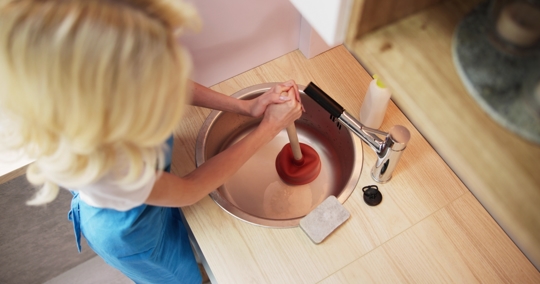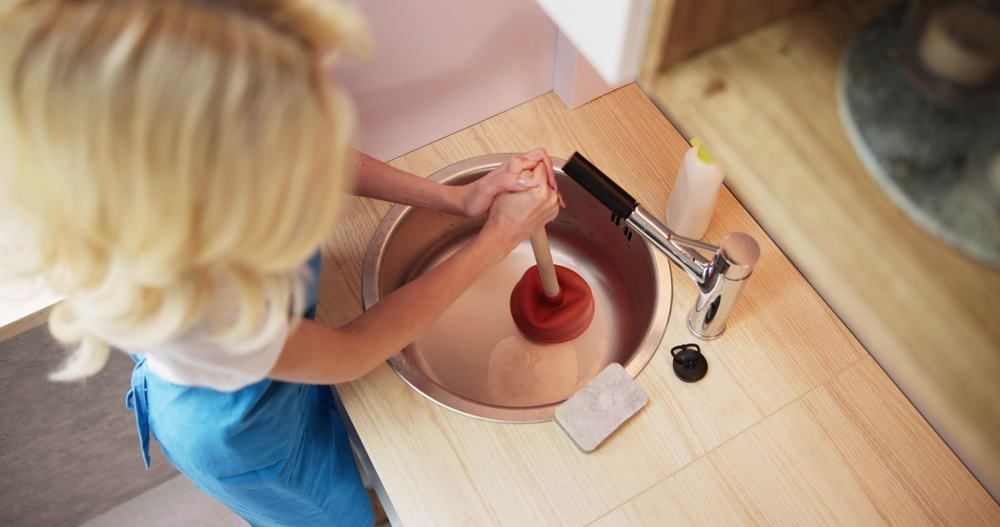Is Something Backed Up?
It usually starts with something small. Maybe the sink drains slower than usual. Maybe your shower starts to resemble a shallow kiddie pool. Or—heaven forbid—you smell something unpleasant wafting from the kitchen sink.
If you’ve ever experienced one of these red flags, you’re not alone. Drain issues are among the most common plumbing problems homeowners face in the greater Orlando area. The good news? Most can be caught early—and many can even be prevented with the right know-how.
Here’s how to know if you’ve got a clog coming, and what to do about it if you do!
A Quick History of Drains: More Than Just Pipes
Drains have come a long way from ancient Roman aqueducts. In fact, indoor drainage systems as we know them are a fairly modern luxury. Here's a look at the most common drains in your home—and their surprisingly interesting backstories:
Kitchen Sink Drains
The kitchen sink evolved as indoor plumbing became common in the early 20th century. But it was George W. M. Lacy who patented the modern sink drain trap in 1880—an innovation that prevents sewer gases from creeping back up. Kitchen drains today handle everything from pasta water to food scraps (often via a garbage disposal). But all that traffic makes them especially prone to clogs.
Bathroom Sink and Shower Drains
The concept of the bathroom as a dedicated hygiene space began in the Victorian era, but it wasn't until the 1930s and '40s that most American homes were built with dedicated indoor bathrooms. Shower and sink drains handle soap, toothpaste, and, of course, hair—which tends to clump together and catch on other debris, creating those frustrating slow-drain scenarios.
Bathtub Drains
Bathtubs have ancient roots, but the modern version surged in popularity after World War II. Tub drains are similar in design to shower drains, but because they sit horizontally and are used less frequently, they’re even more prone to slow buildup over time.
Toilet Drains
Sir John Harington invented a prototype of the flush toilet in 1596, but it wasn’t until Thomas Crapper refined the design in the late 1800s that toilets started to resemble today’s models. Toilet drains are among the widest in the house, but they’re also the most sensitive to what you put down them. (Spoiler alert: Only flush toilet paper and waste. That “flushable” wipe? Not your friend.)
Floor drains, especially in laundry rooms or garages, are often overlooked until something floods. These drains are your first line of defense against standing water—but because they don’t see regular use, debris and dust can settle in, forming tough clogs over time.
Why Do Drains Get Clogged in the First Place?
Drains are like the blood vessels of your home—essential, but easy to ignore until there’s a blockage. In the kitchen, fats, oils, and grease often go down as liquids but solidify in cooler pipes, trapping food scraps and leading to sticky clogs. In the bathroom, hair binds with soap residue to form dense clumps that slow water flow. Hard water—which Central Florida has in abundance—leaves behind mineral deposits that narrow your pipe diameter over time. And while toilet drains are built for flushing, they’re not invincible: wipes, feminine products, and even too much toilet paper can overwhelm the system.
Outdoor factors play a role too. In older homes, tree roots can creep into underground sewer lines through tiny cracks, eventually causing full blockages that affect every drain in the house. Sometimes the issue is age—older plumbing systems made from cast iron or clay just aren’t built to withstand decades of buildup.
How to Spot the Signs of a Drain Problem
So how do you know if your home has a drain issue before it becomes a plumbing emergency?
Watch for telltale signs. Gurgling noises in your sinks or toilets often signal that air is trapped due to a blockage. Slow drainage that gets worse over time suggests buildup is growing inside your pipes. If water backs up into your tub or shower when using other fixtures, you may have a clog in your main drain line. And if unpleasant odors are sneaking up from your kitchen or floor drains, chances are something’s decomposing in there. Trust your senses—if anything seems off, it probably is.
What You Can Do to Keep Drains Clear
Good drain health starts with prevention. In the kitchen, never pour grease or oil down the drain—no matter how hot the water is. Instead, collect it in a jar or can and toss it in the trash. Use drain catchers in sinks and showers to trap food particles and hair before they go down the pipes. And once a month, flush your drains with hot water or an enzyme-based cleaner to break down residue naturally without harming your plumbing.
Toilets are simple: only human waste and toilet paper should be flushed. Even wipes that claim to be “flushable” don’t break down fast enough and can cause serious blockages.
And for floor drains, especially in areas you don’t use often, pour water down them occasionally to keep the trap from drying out—and keep odors and pests out. If your home has a history of clogs or you’re not sure what’s going on underground, scheduling an annual inspection is one of the smartest moves you can make.
🎉 Special Offer: Get Ahead of Plumbing Problems—For Free!
At ServiceOne Air Conditioning & Plumbing, we believe that a little prevention goes a long way—especially when it comes to your drains.
Now through June 30, 2025, we’re offering a FREE whole-home plumbing inspection with any plumbing service call—a $129 value, yours at no extra charge!
This isn’t just a quick once-over. Our licensed plumbing pros will perform a thorough, room-by-room check of your home's plumbing system. We'll look for leaks, slow drains, pressure issues, and early warning signs that could lead to bigger problems down the line. It’s peace of mind today—and protection for your home tomorrow.
So whether your sink is slow, your toilet's bubbling, or you just want to make sure everything’s in top shape, now is the perfect time to act.
Call ServiceOne today or schedule your appointment online to take advantage of this limited-time offer. Your drains—and your wallet—will thank you.
No more drain pain!


